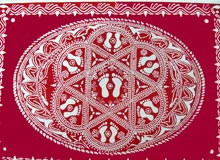 Aipan is one of the traditional forms of Rangoli, practiced in the state of Uttarakhand, now Uttaranchal. The art is associated with a great degree of social, cultural as well as religious significance. In Uttarakhand, Aipan designs are mainly drawn at places of worship, along with the main entry door and the front courtyard of the house. In the Indian subcontinent, the art form of Aipan is carried on from generation to generation.
Aipan is one of the traditional forms of Rangoli, practiced in the state of Uttarakhand, now Uttaranchal. The art is associated with a great degree of social, cultural as well as religious significance. In Uttarakhand, Aipan designs are mainly drawn at places of worship, along with the main entry door and the front courtyard of the house. In the Indian subcontinent, the art form of Aipan is carried on from generation to generation.Women pass on the patterns to their daughters and daughters-in-law. Some of the patterns are significant from a religious point of view and are especially made at the time of ceremonies like marriages, threading ceremony, naming ceremony, etc, to perform rituals. Each and every Aipan design has a particular meaning attached to it and is drawn with a specific purpose in mind. Given below are the some of the most popular Aipan designs.
Traditional Aipan
The main designs of traditional Aipan are linear art, geometrical designs, flowers and imprints, drawn for ornamental purposes.
Aipan of Door Step
The Aipan drawn on the doorstep of the house has a beautiful design and great artistic value. At times, Vasudhara is also combined with this design to give it a more elegant look.
Vasudhara
Vasudhara is made around the Pooja Vedika, doorsteps of house, worship place and Tulsi plant. The place, that is to be decorated, is painted with Geru (red color soil) and then, vertical lines, in odd numbers like 5, 7, 9 or 11, are made on it with the help of Bishwar (soaked rice powder).
Swastika
In case the Aipan of a particular occasion is not known, a swastika is drawn. Swastika symbolizes creation and growth and encourages people to march ahead in the search of success.
Astadal Kamal
Astadal Kamal is the aipan drawn at the place of a Havan. Its design includes an octagonal geometry, with lotus petals, and a swastika in the middle.
Lakshmi Padchinha
Lakshmi Padchinha, comprising of the footprints of Goddess Lakshmi, is drawn on Deepawali, right from main entrance of the house to the worship place.
Lakshmi Peeth
Lakshmi Peeth is drawn on Deepawali in the puja room.
Bhuiyan
Bhuiyan pattern is made on the outer side of a Soop (an ugly sketch of a demon). The inner side of the 'Soop' has the image of Lakshmi-Narayan.
Dhuliarghya Var Chauka
Dhuliarghya Var Chauka is drawn at the time of marriage. When the bridegroom is introduced and welcomed by the bride's family, he stands on the Chauka only.
Acharya Chauka
Acharya Chauka is made for the kulguru, who stands on it while performing the marriage rituals from bridegroom's side, at the time of dhuliarghya
Janeo
Janeo Aipan is drawn for the ceremony of 'Janeo' i.e., the threading ceremony, of a boy. The pattern has 15 dots in the center.
Bhadra
Bhadra form of Aipan is drawn in the puja room and at the time of a yajna. It is further subdivided into several forms, based on the number of dots it has. The bhadra with 12 dots is known as bindu bhadra, while the one with 24 dots is known as bindu bhadra.
Namkarna Chauki
Namkarna Chauki is the naming ceremony of a newborn, held on the eleventh day of his birth. Namkarna Chauki Aipan is drawn in the courtyard, where the surya darshan (baby's first exposure to the sun) is performed.
No comments:
Post a Comment